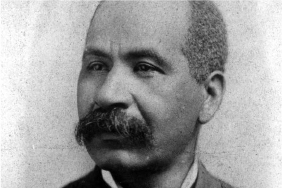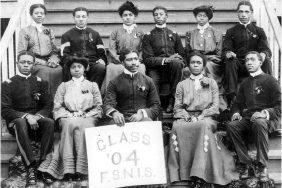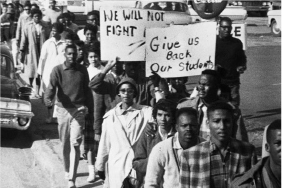Florida A&M University History
For more than 130 years, Florida A&M University has served the citizens of the State of Florida and the nation through its provision of preeminent educational programs...programs that were the building blocks of a legacy of academic excellence with caring. FAMU, “Florida’s Opportunity University,” is committed to meeting the challenges and needs of future generations.
A Look Back
Our history reaches deep into Florida’s past. 11 presidents, 7 interim presidents, and 130+ years of excellence
FAMU was founded on October 3, 1887. It began classes with 15 students and 2 instructors.
How the State Normal and Industrial College for Colored Students became Florida Agricultural and Mechanical College for Negroes (FAMC)
History Makers
How Florida A&M College became Florida Agricultural and Mechanical University.
The ’50s and ’60s were times of social unrest and change in the nation.
History Makers
How the University grew to 11 schools and colleges and a Division of Graduate Studies and Continuing Education.
These leaders steered the way through a time of change toward success.
In 1992, 1995 and 1997, FAMU enrolled more National Achievement finalists than Harvard, Yale and Stanford.
Historical Overview
Florida Agricultural and Mechanical University (FAMU), founded on October 3, 1887, as the State Normal College for Colored Students, began classes with 15 students and two instructors. FAMU’s destiny--to become an institution of higher learning, striving toward even greater heights of academic excellence. Today, Florida A&M University is one of 12 institutions in Florida’s State University System, and “Excellence with Caring” remains its goal.
Leading the State Normal College through its infancy were two distinguished citizens and educators. They were Thomas DeSaille Tucker, an outstanding attorney from Pensacola who was selected as the college’s first president, and Thomas Van Rennasaler Gibbs, a state representative from Duval County who was Tucker’s top assistant. In 1891, the college received $7,500 under the Second Morrill Act for agricultural and mechanical arts education; thus, it became Florida’s land grant institution for blacks. The college was moved from Copeland Street (now the site of Florida State University) to its present location, and its name was changed to the State Normal and Industrial College for Colored Students. It was at this new site that President Tucker initiated his plans for institutional growth and development.
In the 1900s, this young institution flourished under the leadership of Nathan B. Young. In 1905, management of the college was transferred from the Board of Education to the Board of Control. This event was significant because it officially designated the college as an institution of higher education. The name was changed in 1909 to Florida Agricultural and Mechanical College for Negroes (FAMC). The following year, with an enrollment of 317 students, the college awarded its first degrees. After a fire destroyed Duval Hall (the main building that housed the library, administrative offices, cafeteria and other college agencies), progress was made when Andrew Carnegie donated $10,000 to the University for the erection of a new library facility. This facility held the distinction of being the only Carnegie Library located on a black land-grant college. President Young directed the growth of the college, with limited resources and expectations, to a four-year degree-granting institution, offering the Bachelor of Science degree in education, science, home economics, agriculture, and mechanical arts.
Under the administration of John Robert Edward Lee, Sr., Florida A&M College acquired much of the physical and academic image it has today. Buildings were constructed; more land was purchased; additional faculty was hired; courses were upgraded; and accreditation was received from several state agencies. By 1944, Florida A&M College had constructed 48 buildings, accumulated 396 acres of land, and had 812 students and 122 staff members. In 1949, under the guidance of William H. Gray, Jr., expansion, along with reorganization, continued; the college obtained an Army ROTC unit, and student enrollment had grown to more than 2,000.
Perhaps the greatest achievement under the presidency of Dr. George W. Gore, Jr. [1950-1968], was the elevation of the school to university status. In 1953, the college’s name and status were changed by legislative action from Florida Agricultural and Mechanical College to Florida Agricultural and Mechanical University (FAMU). Obtaining university status meant restructuring existing programs and designing new academic offerings to meet the demands of producing quality students at the professional and graduate levels. Between 1953 and 1968, the Schools of Pharmacy, Law, Graduate Studies, and Nursing were also created.
During the years 1950-68, the University experienced its most rapid growth. Twenty-three buildings were erected, with construction and renovation costs totaling more than $14 million. These facilities included: the Dairy Barn, Faculty Duplexes, Law Wing of Coleman Library; Gibbs, Tucker, and Truth Halls; Agriculture and Home Economics Building (Perry Paige), Student Union Building, Demonstration School Building and Cafeteria; Health and Physical Education Building, Music and Fine Arts Complex, High School Gymnasium and Stadium. The hospital was completed and operative. The university’s staff was increased by more than 500. At this time, the four-quarter plan was implemented, and the school became the first black institution to become a member of the Southern Association of Colleges and Schools. Enrollment increased to more than 3,500.
With Dr. Benjamin L. Perry, Jr., at the helm, the 1970s brought further growth to the University. FAMU experienced a decade of rapid transition when federal laws were demanding a desegregated unitary system. Dr. Perry’s administration is credited with preservation of FAMU’s autonomy. In 1971, FAMU was recognized as a full partner in the nine-university, public higher education system of Florida. The program and academic areas within the institution were extended to include the Black Archives Research Center and Museum, established as a state repository for black history and culture; the Division of Sponsored Research; the program in medical sciences, in conjunction with FSU and the University of Florida; the development of the School of Architecture; a Naval ROTC unit; establishment of the cooperative programs in agriculture; and a degree-granting program in Afro-American Studies. Enrollment at FAMU increased from 3,944 (1969) to 5,024 (1970). The university was reorganized into academic areas instead of departments. The physical plants were improved by the construction of the Women’s Complex (apartment type dormitory), Clifton Dyson Pharmacy Building, new poultry building and dairy cattle resting shed and renovation of University Commons, Coleman Library, Tucker Hall and the FAMU Hospital into the presently named, Foote-Hilyer Administration Center (FHAC).
The 1980s served as a model for productive development. Under the administration of Dr. Walter L. Smith, the University grew to eleven schools and colleges, and a division of graduate studies, research, and continuing education. In 1984, the University was granted the authority to offer its first Doctor of Philosophy degree, the Ph.D. in Pharmacology. The 1980s also saw the expansion of the Gaither Athletic Center, which includes the construction of a new Women’s Athletic Complex equipped with a track, an Olympic pool, men’s and women’s weight training rooms, and softball and baseball fields. Bragg Memorial Stadium was renovated and expanded to provide seating for some 25,500 spectators, and a modern field house was erected. The old laundry was converted into the Industrial Education Classroom-Laboratory. New facilities were constructed to house the Schools of Allied Health Sciences, Architecture, Business and Industry, and Nursing. Construction and renovation projects amounted to more than $34 million. Under the leadership of Dr. Smith, the University launched the Centennial Celebration Fund for establishment of a university endowment.
In 1985, construction of a new corridor of history begun as Dr. Frederick S. Humphries became the eighth president of Florida A&M University. Under his leadership, FAMU experienced significant growth and unsurpassed accomplishments. President Humphries had the distinction of presiding over the University’s Centennial Celebration: October 2, 1986-December 31, 1987. This commemorative event, which centered upon the theme, “A Legacy to Preserve-A Future to Design,” was initiated with the president’s inauguration, highlighted with many activities (lectures, concerts, convocations, etc.) and honors, and culminated with the burial of a time capsule.
Dr. Humphries’ unique administrative initiatives heightened the appeal for FAMU to high school students, parents, and other members of the public. Some of the achievements made during President Humphries’ administration include the following: FAMU received national recognition for record-breaking enrollment. In 1985, enrollment was 5,100. By 1992, total enrollment had nearly doubled to 9,551. The enrollment for the 1998/99 academic year reached approximately 12,000.
In addition to increased enrollment, the University consistently ranked nationally among the top five colleges and universities for enrolling National Achievement finalists. Due to an aggressive and competitive campaign to attract more talented students, FAMU climbed steadily from fourth place in 1989 to first place (1992, 1995, and 1997), and second place (1993 and 1994), surpassing institutions such as Harvard, Yale, and Stanford. Black Issues in Higher Education also cited FAMU, in 1999, for awarding more baccalaureates to African Americans than any institution in the nation.
Most significantly, during the celebration of its 110th Anniversary, TIME Magazine-Princeton Review selected Florida A&M University as the 1997-98 College of the Year. FAMU was selected as the winner from among six finalists including: DePaul University, Chicago; DePauw University, Greencastle, Indiana; the University of Iowa, Iowa, City, Iowa; University of California, Los Angeles; Trinity College, Hartford, Connecticut; and the University of California State System. FAMU was the first institution in the country to receive this honor from this magazine.
FAMU successfully completed requirements for establishing eight Eminent Scholars Chairs through the State Major Gifts Program: the Warner-Lambert Chair in the College of Pharmacy and Pharmaceutical Sciences; the Garth Reeves and the Knight Foundation Chairs in the School of Journalism and Graphic Communication; the Anheuser-Busch, Centennial and Financial Services Chairs in the School of Business and Industry; the Carrie Meek Chair in the College of Education and the Foster Edmonds Chair in the College of Arts and Sciences.
At the 1989 Spring Commencement exercises, the University awarded its first Ph.D. degree to Hyacinth Chi Akunne in the College of Pharmacy and Pharmaceutical Sciences. The University presented its second doctor of philosophy degree to Fred Foreman (FAMU-FSU College of Engineering) during the 1995 Spring Commencement Exercises. Presently, the University has 11 programs that offer the doctoral degree. They are pharmaceutical sciences; physics; biomedical, chemical, mechanical, civil, industrial and electrical engineering; educational leadership; environmental science; and entomology - a cooperative program with the University of Florida.
FAMU displayed excellence both in and outside the classroom. In 1989, the FAMU Marching “100” Band, led by Director of Bands Dr. William P. Foster, was invited by the French government to participate in the Bastille Day Parade as the official representative from the United States. This event was held in celebration of the Bicentennial of the French Revolution. The Marching “100” continues to perfect its legacy of excellence, which has resulted in it being labeled as the “Best Marching Band in the Nation” by Sports Illustrated (August, 1992). The band received national recognition, in January 1993, when it performed in the 52nd Inauguration Parade in Washington, D.C., by invitation of President William “Bill” Clinton. The Marching “100” performed for the second Clinton inaugural parade as well as for the 2009 inauguration parade of President Barack Obama.
Tremendous efforts have been made to upgrade facilities and construct new buildings during the past decade. Completed projects include construction of the Benjamin L. Perry General Classroom and Science Research Building; expansion of the School of Business and Industry’s east and west wings; the FAMU/FSU College of Engineering; the new College of Pharmacy and Pharmaceutical Sciences building; expansion of the School of Allied Health Sciences; a new Student Services Center; a 400-car parking garage; a 360-bed expansion at Palmetto Housing; remodeling and expansion of the Foster-Tanner Complex; and construction of the Frederick S. Humphries Science Research Center. Other completed projects include the School of Journalism and Graphic Communication’s building and the Campus Recreation Center, the FAMU Developmental Research School (FAMU-DRS) campus, the Multipurpose Gymnasium and the renovation of the Commons Building.
Leadership in the new millennium
January 2002, Henry Lewis III, Pharm. D, Dean of the College of Pharmacy and Pharmaceutical Sciences, was appointed interim president by the Board of Trustees.
May 17, 2002, the Board of Trustees named Fred Gainous, Ed. D., an alumnus, the ninth president of FAMU. Prior to his presidency, Dr. Gainous was the chancellor of the State Community College System in Alabama.
December 14, 2004, the Florida A&M University Board of Trustees named Castell Vaughn Bryant, Ed. D., interim president.
February 2007, James Ammons, Ph.D., chancellor of North Carolina Central University in Durham, N.C., was named the 10th president of Florida A&M University. Dr. Ammons served as provost and vice president for Academic Affairs for Florida A&M University from October 1995 until becoming chancellor of North Carolina Central University in 2001. Dr. Ammons commenced his presidency at Florida A&M University on July 2, 2007.
July 2012, Larry Robinson, Ph.D., was appointed interim president by the University Board of Trustees.
President Elmira Mangum, Ph.D., began her tenure as the 11th president of Florida Agricultural and Mechanical University (FAMU) on April 1, 2014.
September 2016, Larry Robinson, Ph.D., was appointed interim president by the University Board of Trustees. This was Robinson's third stint as FAMU's interim president, including from July of 2012 to April of 2014.
November 2017, Larry Robinson, Ph.D., became the 12th president of Florida A&M University. Dr. Robinson served as provost and vice president for academic affairs from 2003 to 2005. In 2007, he served briefly as chief operating officer for the University and subsequently as vice president for Research from 2007-2010. Dr. Robinson took a leave of absence from the University to serve as assistant secretary for Commerce for Conservation and Management at the National Oceanic and Atmospheric Administration, where he supported and managed NOAA’s coastal and marine programs, including marine sanctuaries for preserving areas of special national significance, fisheries management to sustain economic prosperity, and nautical charts for safe navigation. He returned to FAMU in November 2011.
In 2019-2020, FAMU has experienced another period of unprecedented construction with the completion of the 700-bed FAMU Towers residence hall, the Center for Access and Student Success, (CASS) student services complex, and an outdoor amphitheater.
FAMU can credit much of its present academic stature to the leadership of its distinguished presidents:
Thomas DeSaille Tucker (1887-1901)
Nathan B. Young (1901-1923)
John Robert Edward Lee, Sr. (1924-1944)
William H. Gray, Jr. (1944-1949)
George W. Gore, Jr. (1950-1968)
Benjamin L. Perry, Jr. (1968-1977)
Walter L. Smith (1977-1985)
Frederick S. Humphries (1985-2001)
Fred Gainous (2002-2004)
Dr. James H. Ammons (2007-2012)
And acting presidents:
W.H.A. Howard (1923-24)
J.B. Bragg (1944)
H. Manning Efferson (1949-50)
Henry Lewis III, interim president (2002)
Castell Vaughn Bryant, interim president (2004)
Larry Robinson, Chief Executive Officer (May 2007 – July 2007), interim president
(2012-2014; 2016-17) and president (2017-present).
For more than 130 years, Florida A&M University has served the citizens of the State of Florida and the nation through its provision of preeminent educational programs...programs that were the building blocks of a legacy of academic excellence with caring. FAMU, “Florida’s Opportunity University,” is committed to meeting the challenges and needs of future generations.
How the Past has Influenced the Present.
Over 130 years, FAMU has served the citizens of the State of Florida and the world through its preeminent educational programs. These programs are the building blocks for a legacy of “Excellence With Caring.” For this reason, FAMU is "Florida's Opportunity University.” The school was originally designed to meet the needs of the underrepresented and the underprivileged, and we remain committed to meeting the challenges and needs of future generations.
Under Dr. Robinson's leadership, FAMU continues to thrive and has implemented new recruitment and retention strategies, strengthened the University's academic programs, and more!
One of the best ways to determine if a university is right for you is to visit the campus. We offer campus tours to provide students and their families as well as high school and/or community groups a better understanding of campus life.
We're thrilled that you're applying to Florida A&M University! We offer 54 bachelor's degrees, 29 master's degrees, three professional degrees, and twelve doctoral degrees. Find one that helps you accomplish your goals.














